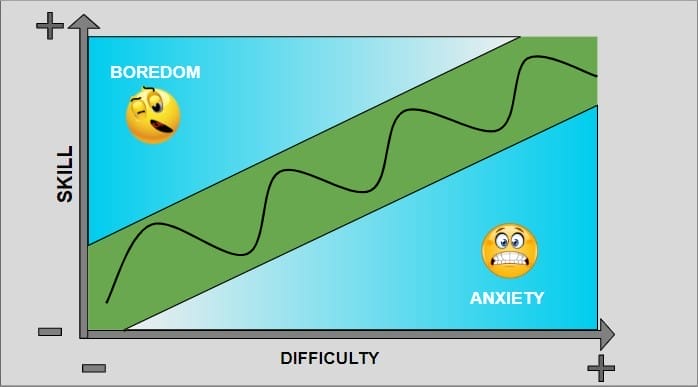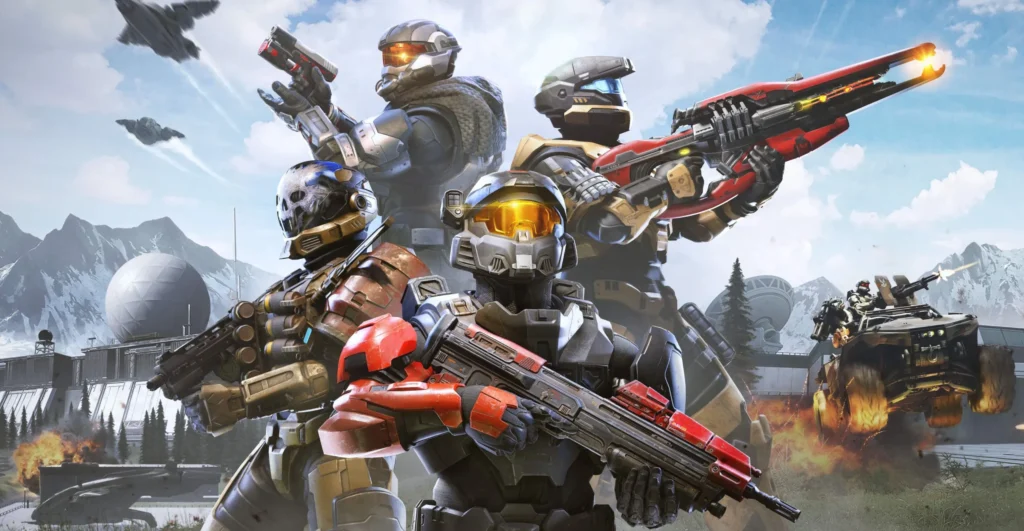Video games achieve peak engagement by getting players into flow state. This means a feeling of focused attention, mind transportation and time flying by.
Understanding the psychology behind flow gives game makers a blueprint for addictive experiences. This article explains the key lessons. It also shows real examples of games using flow to hook players for hours of enjoyment.
Using Flow Theory in the creation of games
What is Flow State
Flow is a trance-like zone where someone is completely focused on an activity.🧘♂️ Their mind feels immersed in the world of that activity.❤️🔥 Hours can sweep by without noticing.😮
The scientist Mihaly Csikszentmihalyi researched flow for decades. He wanted to know why artists would get utterly lost in creative work for hours, feeling amazing after. Yet they had no external rewards driving them.😳
Instead, flow activities give internal motivation to participate. Their enjoyment comes from the very act of doing them. Their intrinsic pleasures naturally pull people to repeat them.🎮
Understanding the traits of flow reveals how to hook audiences on games too.
“Game makers can use flow as blueprint for super addictive experiences. This fuels greater player retention and love for titles.”
Let’s examine the psychology behind flow to make captivating games.
Flow Conditions – The Optimal Zone
Csikszentmihalyi identified key conditions making activities engaging enough to spark flow:

- Challenge-skill balance
- Having clear goals
- Receiving immediate feedback on progress
- Feeling in control rather than externally pushed
- Becoming transported into fantasy worlds away from reality
- Driven by process rather than final outcomes
Mastering these variables unlocks tremendous player retention.📈 Let’s explore why each enables absorption into gaming’s sweet spot.
Challenge-Skill Balance
The #1 trait of flow finds skills balanced against activity difficulty. If challenges overwhelm current abilities, anxiety results. If skills surpass difficulties posed, boredom sets in.
Flow occurs at the optimal spot between anxiety and boredom. This “channel” stretches skills through doable steps that expand them without overmatching them.
| Flow Condition | Psychology & Outcomes |
|---|---|
| Challenges ≫ Skills | Anxiety. Players feel overwhelmed and give up. |
| Skills ≫ Challenges | Boredom. Players lose interest from things being too easy. |
| Challenges ≈ Skills | “Flow“. Players feel tested but engaged, driving mastery.✨ |
For games, this reveals lessons on difficulty pacing. Early levels introduce mechanics gently, then complexity increases to match rising skills. Nice curves prevent bored veterans and frustrated newbies.
Here’s a case story showing this principle in action:
Mario games famously ramp challenge in line with abilities gained. Players master running and jumping, then moving platforms and enemies enter the mix to stretch skills…but not overwhelm. This difficulty progression tunes into flow channel to compel “just one more level” urges for hours.
In essence, well-paced difficulty generates nonstop engagement. Players feel continuously challenged but capable, driving mastery through flow.
Clear Goals & Feedback
Flow states also need clear direction. Goals should require complete focus where progress feedback provides motivation.
Games give obvious goals like defeating bosses or capturing flags. Scoring shows advancement while level milestones supply intermediate goal posts.
Juicy feedback aptly rewards player actions too. Combo indicators, XP bars filling and controller rumbles reinforce tactical successes with crispy feedback. This engrosses players in progressive steps towards broader objectives.
Sense of Control
Flow research reveals people want focused control over growing skills. Distractions break engagement. But perceiving growth in abilities when facing challenges builds confidence.
Games achieve this partly via clear goals and feedback enabling direction. But predictability also empowers agency.
For instance, consistent rules and physics breed trust in outcomes from player inputs. Responsive controls, intelligent cameras and logical rules provide needed predictability. Physics manipulation powers players take mastery over worlds themselves!
This interactivity fosters laser focus because people feel in the driver’s seat guiding experiences.
Escaping into Fantasy Worlds
Mihaly Csikszentmihalyi found intrinsic pleasures in flow derive from mind transportation. People relish escaping normal life into fantasy worlds where they expand abilities without real risk.
Games similarly invite transportation into fresh magical realms away from player realities. The art direction, lore and characters surrounding missions provide fertile soil for planted immersion to bloom.
Rich narratives and imaginative locales fertilize curiosity to unlock what’s behind the next corner. High stakes hooks urge onwards while strong sensory feedback seals suspension of disbelief. Players feel transferred into worlds where hours fly by.
Process Over Outcomes
Another research finding shows flow activities intrigue people more for participation than any final outcomes. Scientists tinker for the research itself as much as discoveries. And athletes pour endless training into betterment for its inherent enjoyment.
Games achieve identical engagement by focusing players on immediate decisions, maneuvers and skills to exercise. Long term completion matters less than navigating challenges currently in front of your face.
Unlocking new abilities or earning high scores become their own dopamine-releasing rewards rather than steps to some external prize. The journey holds meaning making grind rewarding beyond distant ceremonial trophies.
World of Warcraft illustrates this by emphasizing new gear less for statistical improvements, but more for sparking fresh combat options to master for their own enjoyment.
This mastery focus intrinsically pulls players to advance for its own pleasures over some future reward. The process stays engaging.
Applying Flow Theory for Addictive Game Design
Let’s examine practical applications for optimizing engagement by tapping into flow theory:

Dynamic Difficulty Tuning
Creating the perfect challenge-skill balance retains early players while accommodating growth for veterans. Carefully layering mechanics while testing skill acquisition prevents boredom spikes or newbie churn.
Halo trains players on weapons before enemy combinations require orchestration between them. This builds confidence with individual tools before the symphony.
Clear UI Affordances
Clean interface design focuses attention on core gameplay, not deciphering icons. Creative minimalism spotlights mechanical depth more than flashy decoration. Each element should beneficially guide users explicitly.
Fortnite UI gives clear gameplay-forward objectives rather than digital clutter complicating goals. Icons even suggest physical affordances via imagery to suggest in-game interactions.
Predictive Game Physics
Consistency enables player trust in game world rule sets. When outcomes feel fairly tied to inputs, people feel in control to set dominoes falling. Relative physics predictability with occasional surprises aids this.
Portal’s core mechanics show mastery over physics-based gameplay stemming from intuitive, responsive properties. This grants safe spaces to experiment wildly.
Multisensory Immersive Feedback
Vibrant particle effects, emotive music and rumbling controllers enhance transportive sensations into responsive worlds full of feedback urging talents onwards. When games react via sight, sound and touch, belief suspension flows.
Fortnite’s reactive environmental cues make players feel central to living worlds. Structures rumble from explosions while music adapts to in-game events.
Emergent Gameplay Sandboxes
Open possibility spaces with interactive rule sets spur experimentation, creativity and ultimately mastery over systems with high skill ceilings. Emergent gameplay leverages flow by enabling commandeering challenges.
Minecraft and Breath of the Wild allow players unbelievable freedom to tackle challenges. This sense of control over the curriculum hooks their curiosity to explore further.
Reactive & Dynamic Game Music
Audio closely coupled to player actions grabs focus while enhancing transportation into worlds manifesting noticeable reactions. When the game actively listens and responds, flow immersion glues.
Audiosurf’s dynamic music generation based on supplied songs ties feedback, control and reactivity together for tune-twisting mastery & flow transportation.
Mastery as Intrinsic Motivation
Spotlight player repertoire growth through new perks over long term prizes for sustained engagement. Unlocking new physics manipulation abilities intrinsically compels usage for experimental enjoyment over any external rewards promised later.
Ratchet & Clank’s wildly imaginative weaponry intrigues players to keep acquiring gadgets. These function as exotically entertaining toys first, progression tools secondly.
Emphasize Short-Term Goals
Redirect attention from distant milestones onto scenarios directly ahead requiring focus. Emphasize meaningful micro decisions intensifying current moments over delayed gratification from achievements further down road.
Mario Kart’s item system makes momentary decisions around using powerups correctly tactically vital irrespective of race outcomes. This focuses engagement onto now.
Pros of Optimizing for Flow
What benefits arise from tapping flow theory for game design?
Pros
- Strong retention from internally motivated gameplay
- Targeted focus zeroing in on core mechanics
- Evergreen classics standing test of time via engagement optimized for intrigue over flashy gimmicks
Understanding intrinsic motivation makes masterpieces with lasting appeal. Candy Crush showcases retention genius by nailing flow optimization. Its challenges walk the narrow path between boredom and anxiety beautifully. Difficulty ramps synchronize with skill gain for long-haul growth. Chunky juicy candy feedback rewards player advances while clear objectives keep focus tight. This recipe compels “just one more level” without need for decorational tricks.
Simplicity centered on repeatable core flow allows certain games to capture undying love across generations. Short sessions or long all-day binges enjoys the same purity driving engagement. Super Mario Bros remains a paragon achieving this via meticulous choreography between challenged skills and culminating victories urging players onward. Its lessons influence game makers today on excavating essential enjoyable depths supporting the heights reached.
Cons of Ignoring Flow Traits
However, negatively consequences manifest from overlooking conditions enabling flow:
Cons
- Quick player churn: Onboarding fumbles from overwhelming difficulty quickly deflate retention
- Waning veterans: Veterans hitting skill ceilings lose interest taking skills elsewhere
- Narrow lifespans: Reliance on surface-level gimmicks fast tracks irrelevance once novelty fades
Candy Crush clones often stumble out the gates because creators skipped understanding player psychology fundamentals. They reskinned visuals and topics without grasping the vital flow nuances retaining Candy Crush’s sweet spot appeal. Difficulty spikes early led to player bounce-offs before skills developed to handle challenges comfortably. Without mastery focus, clones flopped failing basic retention wisdom.
Other games sidestep early difficulty issues yet hit engagement walls later once veterans conquer shallower skill ceilings. Initial progression systems lack long-term depth enabling advanced play mastery. Thus veterans hit boredom cliffs when their evolving talents outpace static content. By lacking tools supporting skill cultivation, Gravity’s Echo similarly watched formerly dedicated players say goodbye.
For other titles, flow failures arose from emptiness beyond flashy decorations. Reliance on purely visual splendor or narrative tricks without sustainable core gameplay sees temporary flashes quickly fading. These books get judged by covers alone. Once the quickly-read pages showing little substance underneath are turned, interest similarly turns elsewhere. Ensuring compelling progression systems intrinsically reward mastery better ensures lasting magic.
The risks of overlooking player psychology fundamentals manifest in player retention falling off cliffs. Focusing design on sustaining engaging flow states better retains player interest long-term.
Conclusion and Final thoughts
- Flow state sparks peak gaming engagement
- Understanding its psychology enables highly addictive games
- Challenge-mastery balance, clear goals, juicy feedback and mind transportation optimize flow
- Mastering these variables achieves greater player retention
By studying the science behind high-focus states, game makers gain powerful mental model blueprints for repeat user motivation. Visionaries like Nintendo‚ Miyamoto artfully craft flow-forward experiences spanning decades due to respect for these theories manifesting magic in mechanics & systems. They focus engagement around player journey‚Äôs intrinsically rewarding from start to finish.
Ultimately, game designers ignoring lessons from flow and motivation research risk playing with fire. Passion projects embodying wisdom for sustainable engagement stand greater chances at connecting with audiences substantially. Weaving such knowledge into design decisions paves reliable roads toward lasting greatness.
At its heart, flow theory provides guardrails stopping concepts from crashing. And springboards launch successes when respected for fully captivating player mindshare. Internalizing its teachings chart paths to classics remembered for lifetimes.
So where are the flow failures and Mastodon moments of mastery in your game concepts? 🦣
Don´t forget to check our blog for more interesting content on game design theory.






















